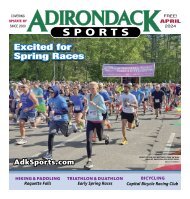Adirondack Sports November 2023
In this issue: 5 NEWS BRIEFS 7 WINTER SPORTS: Adirondack Sports & Northeast Ski Expo 11 RUNNING & WALKING: Turkey Trots - Fly Away Home with the Turkeys 15 ALPINE SKIING & SNOWBOARDING: Start Training for the Slopes 17 NON-MEDICATED LIFE: Potential Benefits of Advanced Cholesterol Testing, Part One 19 COMMUNITY: Buck 50 - An Epic Trail Race is Born 20 ATHLETE PROFILE: Kathy Meany: A Life of Service 23-29 CALENDAR OF EVENTS: A Bounty of Fall and Winter Things to Do 31-39 RACE RESULTS: Top Early Fall Finishers
In this issue:
5 NEWS BRIEFS
7 WINTER SPORTS: Adirondack Sports & Northeast Ski Expo
11 RUNNING & WALKING: Turkey Trots - Fly Away Home with the Turkeys
15 ALPINE SKIING & SNOWBOARDING: Start Training for the Slopes
17 NON-MEDICATED LIFE: Potential Benefits of Advanced Cholesterol Testing, Part One
19 COMMUNITY: Buck 50 - An Epic Trail Race is Born
20 ATHLETE PROFILE: Kathy Meany: A Life of Service
23-29 CALENDAR OF EVENTS: A Bounty of Fall and Winter Things to Do
31-39 RACE RESULTS: Top Early Fall Finishers
You also want an ePaper? Increase the reach of your titles
YUMPU automatically turns print PDFs into web optimized ePapers that Google loves.
NOVEMBER <strong>2023</strong> 17<br />
NON-MEDICATED LIFE<br />
Potential Benefits of<br />
Advanced Cholesterol<br />
Testing, PART ONE<br />
By Paul E. Lemanski,<br />
MD, MS, FACP<br />
Medicines are a mainstay of<br />
American life and the healthcare<br />
system not only because they are<br />
perceived to work by the individuals<br />
taking them, but also because their<br />
benefit may be shown by the objective<br />
assessment of scientific study. Clinical<br />
research trials have shown that some<br />
of the medicines of Western science<br />
may reduce the risk of Type 2 diabetes,<br />
heart attacks, strokes, cardiovascular<br />
death and even some cancers.<br />
In the first 111 installments of the<br />
Non-Medicated Life, a healthy diet and<br />
lifestyle has been shown to accomplish<br />
naturally for the majority of individuals<br />
most of the benefits of medications in<br />
the prevention of the chronic medical<br />
conditions mentioned above. In<br />
order to maximize the benefit of lifestyle<br />
changes it is best to first establish<br />
a baseline of laboratory tests of<br />
so called “surrogate markers” of risk.<br />
Markers such as fasting blood sugar,<br />
Hgb a1c, total cholesterol, HDL (the<br />
good cholesterol) and LDL (the bad<br />
cholesterol) and Triglycerides (blood<br />
fats) are routinely followed serially to<br />
determining increasing or decreasing<br />
risk. After a discussion with your primary<br />
care physician or cardiologist<br />
additional testing may be helpful.<br />
“Advanced” cholesterol testing such<br />
as High Sensitivity C-Reactive Protein<br />
(HS-CRP), Apolipoprotein B (Apo B),<br />
Trimethylamine-N Oxide (TMAO),<br />
and Nuclear Magnetic Resonance<br />
LipoProfile (NMR LipoProfile) may<br />
offer additional identification of risk<br />
and when measured serially may help<br />
direct and refine lifestyle choices. In<br />
this two-part article, Part One will<br />
address the first two advanced tests,<br />
Part Two the remaining advanced tests.<br />
HS-CRP (cardiac CRP) is a mark-<br />
Editor’s Note: This is the 112th in a<br />
series on optimal diet and lifestyle<br />
to help prevent and treat disease.<br />
Any planned change in diet, exercise<br />
or treatment should be discussed<br />
with and approved by your personal<br />
physician before implementation. The<br />
help of a registered dietitian in the<br />
implementation of dietary changes is<br />
strongly recommended.<br />
er of inflammation. Atherosclerosis (literally,<br />
athero equals artery, sclerosis<br />
equals stiffening), the hallmark of arterial<br />
disease-and the cause of heart attacks<br />
and strokes-occurs as a consequence of<br />
inflammation. LDL (the bad) cholesterol<br />
normally exists as spherical particles in<br />
the blood and, generally, when the concentration<br />
is low atherosclerosis risk is<br />
low. However, when excess LDL cholesterol<br />
is produced, it penetrates the arterial<br />
wall, where it forms a structure called<br />
a plaque. A decreased consumption of<br />
the natural antioxidants in vegetables<br />
and fruit results in the LDL in the plaque<br />
becoming oxidized (Ox-LDL). Ox-LDL is<br />
recognized by the immune system as nonself<br />
and is attacked by specialized white<br />
blood cells called macrophages. Literally,<br />
it is the infiltration of macrophages into<br />
the plaque that causes the plaque to<br />
become inflamed setting up the conditions<br />
for a heart attack or a stroke.<br />
In most non-acutely ill individuals<br />
HS-CRP measures the inflammation<br />
caused by the process of atherosclerosis.<br />
Unfortunately, if someone were to<br />
be acutely ill with a cold or flu this could<br />
cause the HS-CRP to be elevated as well.<br />
It is, therefore, best to measure when you<br />
are not acutely ill and if elevated it is best<br />
to remeasure a second time, the lowest<br />
value generally being the most accurate<br />
measure of risk. Individuals with other<br />
inflammatory conditions such as rheumatoid<br />
arthritis and inflammatory bowel<br />
disease may not use the test to indicate<br />
cardiac risk. Physicians may use HS-CRP<br />
to determine whether medication is<br />
needed in individuals at an intermediate<br />
level of cardiovascular risk as determined<br />
by the American Heart Association and<br />
American College of Cardiology risk calculator<br />
(tools.acc.org/ldl/ascvd_risk_estimator).<br />
Elevated HS-CRP values greater<br />
than 3.0mg/dl generally indicate higher<br />
risk, 1-3mg/dl moderate risk, and less<br />
than 1.0mg/dl lower risk.<br />
How does an individual lower HS-CRP<br />
with lifestyle changes? Daily aerobic exercise,<br />
increasing the consumption of vegetables<br />
and fruit, and the consumption<br />
of whole grains as with a Mediterranean<br />
diet, increasing consumption of omega-3<br />
and omega-9 oils (olive), and decreasing<br />
consumption of omega-6 oils, avoiding an<br />
excess of simple sugars, losing weight when<br />
overweight, and stopping smoking, all will<br />
help lower HS-CRP. The benefit of the test is<br />
that it provides you a quantitative measure<br />
of the benefit of such lifestyle changes.<br />
Apo B is another advanced marker of<br />
cardiovascular risk and in clinical trials<br />
proves a better predictor of risk that the<br />
more widely used LDL (bad) cholesterol.<br />
In part, this is because while a major contributor<br />
to risk for most individuals, LDL<br />
is only one of several plaque forming particles<br />
including more rare species called<br />
intermediate density lipoprotein (IDL)<br />
and chylomicron remnants (CR). In part,<br />
it is because LDL particles come in different<br />
sizes that carry different levels of risk.<br />
LDL exists as particles of varied sizes,<br />
some particles being smaller, some medium<br />
sized, and some larger. The relative<br />
number of particles of different sizes<br />
approximate a bell curse in normal individuals,<br />
with medium size particles at the<br />
central portion of the bell curve predominating.<br />
Individuals at higher risk have<br />
proportionately more numerous smaller<br />
particles and fewer medium size and large<br />
particles- at the same total level of LDL.<br />
Moreover, the smaller LDL particles are<br />
more likely to form a plaque because they<br />
more easily penetrate between the cells<br />
that line the artery walls to get deeper layers<br />
where plaque accumulates. Thus, an<br />
LDL equal to 100 mg/dl may be achieved<br />
by more numerous smaller particles or<br />
fewer larger particles and routine testing<br />
does not differentiate between the two.<br />
Because a single apo B molecule is found<br />
in each atherogenic particle regardless of<br />
size, a measure of apo B gives an accurate<br />
measure of all atherogenic particles,<br />
including LDL as well as IDL and CR.<br />
Unfortunately, apo B is a significantly<br />
more expensive test than LDL, and may<br />
not be covered by insurance. However,<br />
a close approximation of apo B derived<br />
risk may be gleaned from a normal,<br />
inexpensive lipid profile by calculating<br />
the non-HDL cholesterol. Indeed,<br />
the National Cholesterol Education<br />
Program (NCEP) guideline recommends<br />
using the non-HDL cholesterol<br />
as a secondary target of treatment after<br />
LDL. In short, the non-HDL cholesterol<br />
equals the total cholesterol – the<br />
HDL (good) cholesterol. Thus, the<br />
total minus the good yields what’s bad<br />
and this would include all bad species<br />
of particles including LDL, IDL and<br />
CR. NCEP recommends a non-HDL<br />
cholesterol 30mg/dl higher than LDL<br />
target. Thus, for example, if you had a<br />
heart attack, the LDL target would be<br />
50-70mg/dl and the non-HDL target<br />
would be 80-100mg/dl.<br />
How do you lower apo B or the<br />
non-HDL cholesterol using lifestyle?<br />
The two most powerful ways would be<br />
weight loss, if overweight, and daily<br />
aerobic exercise. The benefit of this test<br />
is that it provides you a quantitative<br />
measure of the benefit of such lifestyle<br />
changes.<br />
In summary, in most individuals<br />
the standard lipid profile provides<br />
important information in calculating<br />
an individual’s global cardiovascular<br />
risk. More recently, “advanced” cholesterol<br />
testing has become available<br />
to further refine the calculation of risk.<br />
HS-CRP and apo B are two markers of<br />
cardiovascular risk that may help in<br />
this regard. Beginning with a baseline,<br />
serial measures may allow a quantitative<br />
measure of the benefit of lifestyle<br />
changes, and serve as both useful feedback<br />
and an aid in<br />
sustaining such<br />
changes. Look to<br />
Part Two (January<br />
2024) for a discussion<br />
of two additional<br />
“advanced”<br />
tests, TMAO and<br />
NMR LipoProfile.<br />
Paul E. Lemanski, MD, MS, FACP<br />
(plemanski3@gmail.com) is a boardcertified<br />
internist practicing internal<br />
medicine and lifestyle medicine in<br />
Albany. Paul has a master’s degree<br />
in human nutrition, he’s an assistant<br />
clinical professor of medicine at<br />
Albany Medical College, and a fellow<br />
of the American College of Physicians.

















